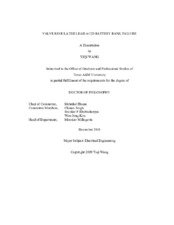| dc.contributor.advisor | Ehsani, Mehrdad | |
| dc.creator | Wang, Yiqi | |
| dc.date.accessioned | 2020-09-11T18:50:29Z | |
| dc.date.available | 2021-12-01T08:44:28Z | |
| dc.date.created | 2019-12 | |
| dc.date.issued | 2019-11-04 | |
| dc.date.submitted | December 2019 | |
| dc.identifier.uri | https://hdl.handle.net/1969.1/189218 | |
| dc.description.abstract | Battery banks play a vital role in many applications, including and not limited to: serve as energy buffer for renewable energy integration, provide high value service for grid support, and function as energy storage for electrical and hybrid vehicles. Albeit their wide usage and great potentials, little research has been conducted into investigating the failure of battery banks. The motivation of this research is to model the failure of battery bank for failure prediction. Most literature focuses on the failure of single battery. When considered in a battery bank setup, individual batteries are assumed identical, and interactions between them are simply neglected. In reality, minor differences between individual batteries lead to them behaving differently in a connected bank from the case of standalone batteries. The accumulating effects of the behavior differences will lead batteries to age and deteriorate at different rates, and eventually lead to unpredicted failures of battery bank. A modified model of lead acid battery with failure mechanisms and aging effects considered has been proposed. This model is then thoroughly investigated to study the failure of individual battery. Failure modes of single battery is defined based on the well-defined failure mechanism found in literature. This model is then used for studying battery bank failure. Failure modes of battery banks are defined based on single battery failure modes. To simulate the interaction between batteries in a battery bank, parameters of individual batteries within the bank are randomly chosen assuming normal distribution. Different topologies of the battery bank has been investigated and compared. A meshed topology has been proposed for its ability to balance batteries and increased reliability. A model based battery bank failure prediction methodology is proposed. Method for battery bank failure prediction based on parameter estimation and classification has been studied. Parameter estimation is carried out using filtering method to extract battery initial parameters based on measurements and imperfect model. Different classification approaches have been tested. Machine learning algorithms are compared when applied to classify battery banks of a specific topology into normal and abnormal failure groups. Their performance are compared using statistic tests. | en |
| dc.format.mimetype | application/pdf | |
| dc.language.iso | en | |
| dc.subject | VRLA Battery | en |
| dc.subject | Failure mode | en |
| dc.subject | Failure Mechanism | en |
| dc.subject | Battery Bank | en |
| dc.title | Valve Regulated Lead Acid Battery Bank Failure | en |
| dc.type | Thesis | en |
| thesis.degree.department | Electrical and Computer Engineering | en |
| thesis.degree.discipline | Electrical Engineering | en |
| thesis.degree.grantor | Texas A&M University | en |
| thesis.degree.name | Doctor of Philosophy | en |
| thesis.degree.level | Doctoral | en |
| dc.contributor.committeeMember | Singh, Chanan | |
| dc.contributor.committeeMember | Bhattacharyya, Shankar | |
| dc.contributor.committeeMember | Kim, Won-Jong | |
| dc.type.material | text | en |
| dc.date.updated | 2020-09-11T18:50:29Z | |
| local.embargo.terms | 2021-12-01 | |
| local.etdauthor.orcid | 0000-0003-0596-1444 | |


